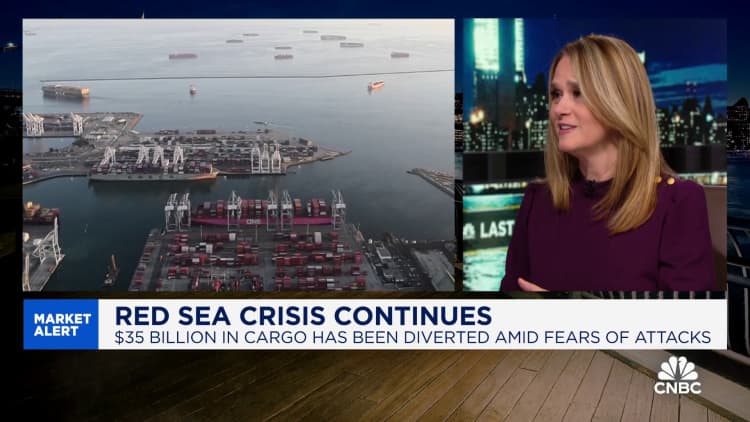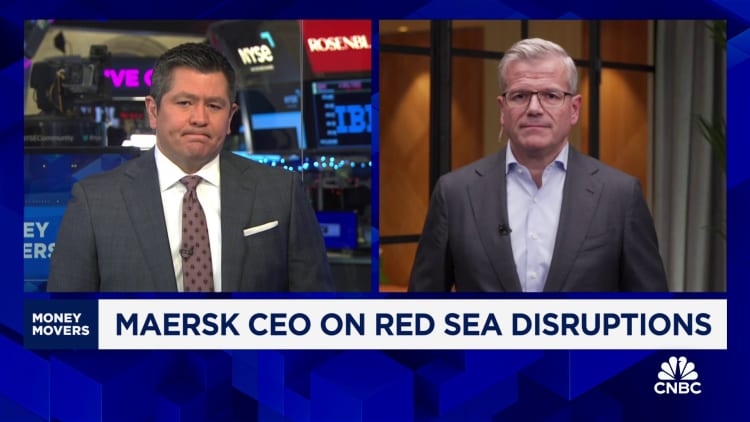
So far, shippers have diverted about more than $30 billion worth of cargo away from the Red Sea as they face the threat of attacks from Houthi militants in Yemen.
Carriers are re-routing vessels as a direct result of 15 strikes in the Middle Eastern body of water since the start of the Israel-Hamas war in October. U.S. Defense Secretary Lloyd Austin announced the formation of an international task force to address security issues.
Details of the U.S.-led operation are yet to be confirmed. Dan Mueller lead analyst for the Middle Eastern Region for maritime security firm Ambrey said they continue to advise clients to continue with their Best Management Practices by thoroughly checking their vessel fleet’s current and past affiliations, the vessel’s Transit Risk Assessment, preparating the crew for emergencies and other safety measures.
At the moment, there are 57 container vessels sailing the long way around Africa instead of cutting through the Red Sea and the Suez Canal, according to Paolo Montrone, senior vice president and global head of trade sea logistics at Kuehne+Nagel.
“That number will increase as more will take this routing,” Montrone told CNBC. “The total container capacity of these vessels is 700,000 twenty-foot equivalent units (TEUs.)” Containers come in both 20-foot and 40-foot units.
The approximate value of those containers is $50,000, according to Antonella Teodoro, senior consultant for MDS Transmodal. That adds up to $35 billion in total cargo being diverted.
Ocean carriers and companies are in a race to explain to U.S. shippers the delays they could be facing as a result of the Houthi threat. The Houthis, a militant group backed by Iran, have expressed solidarity with Palestinian extremist organization Hamas in its war against Israel. Earlier Tuesday, U.S. Defense Secretary Lloyd Austin announced the formation of an international task force to address the security issues.
Carriers could deploy additional vessels since fleet capacity has grown by more than 20% in the last 12 months, according to Teodoro.
“Demand is expected to remain flat so there is capacity available to keep ocean carrier lines on time and pick up the containers once bound on these diverted vessels,” Teodoro told CNBC.
“Ocean carriers could also start making adjustments to their networks in addition to the diversions,” said Teodoro.”But, diversions/adjustments will require time and won’t come free, understandable. One can hope we won’t see the high rates seen in the recent past.”
Teodoro stressed the disruptions at both the Suez and Panama canals highlight the importance of an international authority monitoring how capacity is offered and at what price if we want a more resilient global supply chain. The Panama Canal, located in Central America, has struggled with low water levels for months.
Port authorities are expecting congestion as a result of updated arrival times and planning needs, according to Montrone.
“The situation is very volatile and the reconfiguration of these networks is very complex, so we can expect a certain level of disruption,” Montrone told CNBC. “In Asia, the lack of empty equipment (containers) will become a potential issue as the repositioning of empty containers into demand areas will take 10-20 days longer.”
Maersk, one of the shippers who paused operations in the Red Sea, expects two to four weeks of delays, according to CEO Vincent Clerc.
“Europe is more dependent on the Suez,” Clerc told CNBC’s “Market Movers.” “The delays will be more pronounced in Europe.”

For U.S. shippers, there are a variety of ways for trade to move, either from Asia to the West Coast ports or traversing through the Panama Canal to the Gulf and East Coast ports. Delays from the Panama Canal had shippers opting to book vessels using the Suez Canal as a way to get to the East Coast instead.
SEKO Logistics told CNBC it’s telling U.S. clients to anticipate delays of approximately 10-14 days for East Coast cargo, with potential further delays at ports if a lot of ships arrive at similar times outside of their respective berthing windows.
A diversion around the Cape of Good Hope at Africa’s southernmost point adds around 3,400 nautical miles, or approximately 14 extra days, depending on speed, according to Matthew Burgess, VP of global ocean services at C.H. Robinson.
“Keep in mind, pausing transit and elongating it could put a strain on capacity globally, not just in the Red Sea, and will then lead to carriers imposing rate increases and War Risk Surcharges,” Burgess said. “Our team is in constant contact with ocean carriers and customers whose freight is or may be impacted. Contingency plans are crucial during these types of disruptions. It’s not just thinking through shifted or delayed ocean freight, we’re also strategizing what that means down the line for inland movement, inventory and manufacturing needs.”
ITS Logistics, meanwhile, is telling U.S. clients that the situation in the Red Sea and the Suez Canal is developing quickly, and that it could take weeks, if not months, to be resolved, according to Paul Brashier, vice president of drayage and intermodal for the company.
“We are recommending that shippers shipping goods from Southeast Asia to the US that were using the Suez Canal to consider booking the Trans-Pacific route to the U.S. West Coast,” said Brashier.
Brashier said the lower rates and transit are ideal and any eastbound containers could be moved by rail or truck.
OL-USA, likewise, is advising clients to utilize a multi-pronged approach for their shipments.
“This will involve using all 3 coasts to capture as much vessel space as required, as well as using rail and truck capacity,” said Alan Baer, CEO of OL-USA. “Shippers should also be looking to book ocean freight space from now through early February to allow for possible extended transit times.”
Logistics executives are also worried about a rapid increase in freight rates.
In June 2022, Congress passed the Ocean Shipping Reform Act, giving the Federal Maritime Commission (FMC) the tools it needed to clamp down on ocean carriers’ shipping price hikes.
“The FMC will monitor the rates very closely and see if there are any violations of the Shipping Act which prevents unreasonable behavior by the ocean carriers,” FMC Chairman Dan Maffei told CNBC.

